The Intel Kaby Lake-X i7 7740X and i5 7640X Review: The New Single-Threaded Champion, OC to 5GHz
by Ian Cutress on July 24, 2017 8:30 AM EST- Posted in
- CPUs
- Intel
- Kaby Lake
- X299
- Basin Falls
- Kaby Lake-X
- i7-7740X
- i5-7640X
Shadow of Mordor
The next title in our testing is a battle of system performance with the open world action-adventure title, Middle Earth: Shadow of Mordor (SoM for short). Produced by Monolith and using the LithTech Jupiter EX engine and numerous detail add-ons, SoM goes for detail and complexity. The main story itself was written by the same writer as Red Dead Redemption, and it received Zero Punctuation’s Game of The Year in 2014.
A 2014 game is fairly old to be testing now, however SoM has a stable code and player base, and can still stress a PC down to the ones and zeroes. At the time, SoM was unique, offering a dynamic screen resolution setting allowing users to render at high resolutions that are then scaled down to the monitor. This form of natural oversampling was designed to let the user experience a truer vision of what the developers wanted, assuming you had the graphics hardware to power it but had a sub-4K monitor.
The title has an in-game benchmark, for which we run with an automated script implement the graphics settings, select the benchmark, and parse the frame-time output which is dumped on the drive. The graphics settings include standard options such as Graphical Quality, Lighting, Mesh, Motion Blur, Shadow Quality, Textures, Vegetation Range, Depth of Field, Transparency and Tessellation. There are standard presets as well.
We run the benchmark at 1080p and a native 4K, using our 4K monitors, at the Ultra preset. Results are averaged across four runs and we report the average frame rate, 99th percentile frame rate, and time under analysis.
For all our results, we show the average frame rate at 1080p first. Mouse over the other graphs underneath to see 99th percentile frame rates and 'Time Under' graphs, as well as results for other resolutions. All of our benchmark results can also be found in our benchmark engine, Bench.
MSI GTX 1080 Gaming 8G Performance
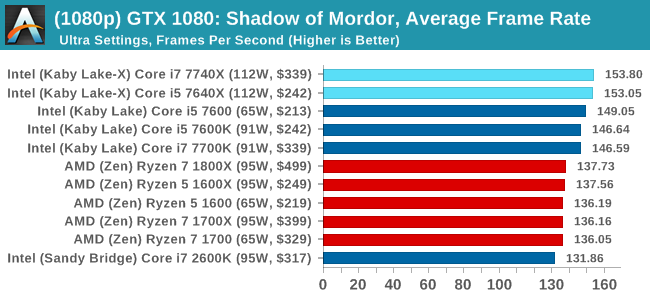
1080p

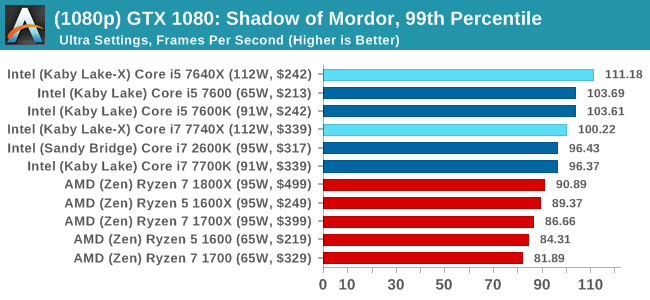
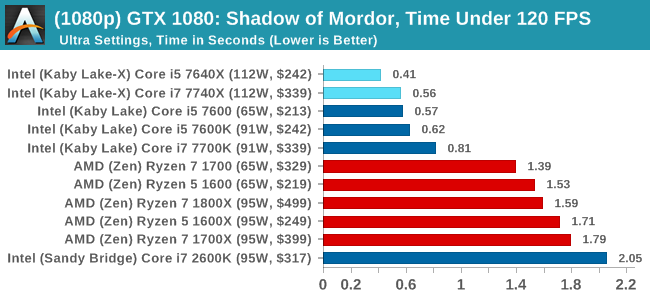
4K
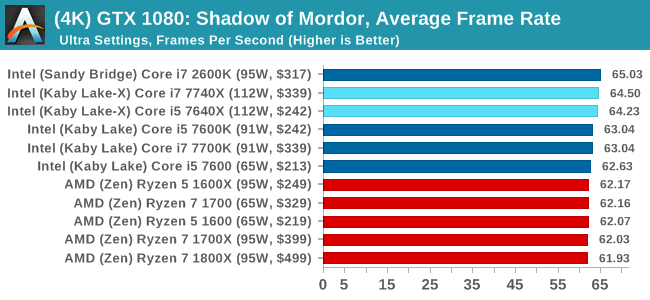
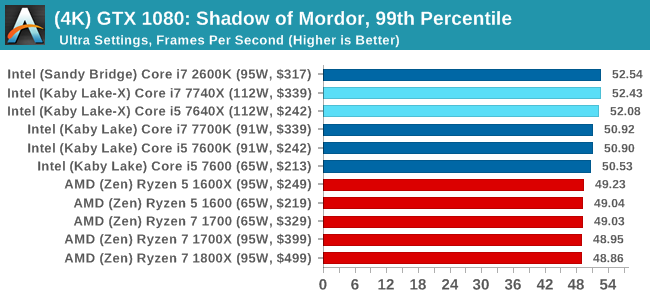
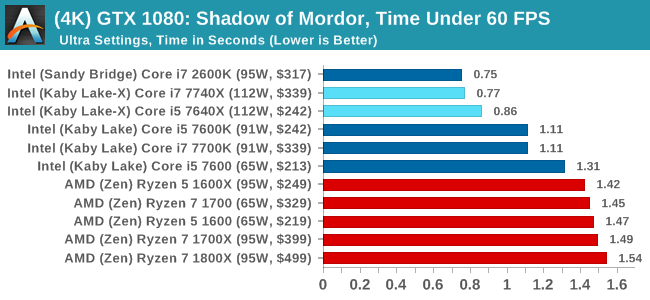
ASUS GTX 1060 Strix 6GB Performance
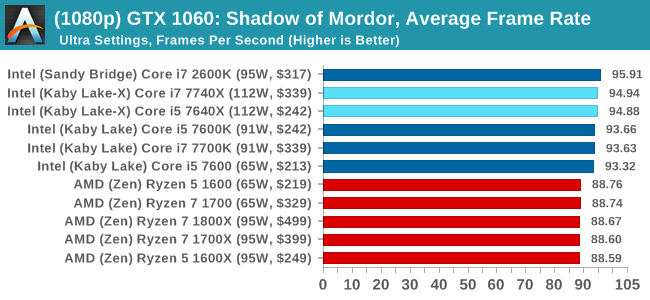
1080p

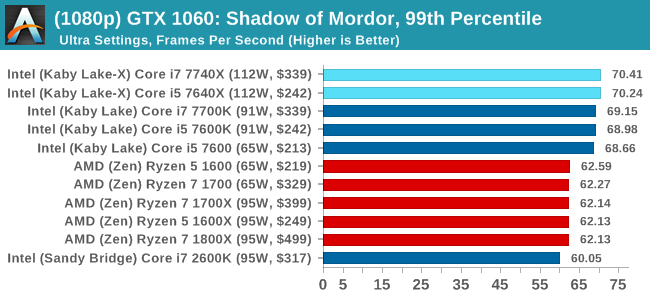
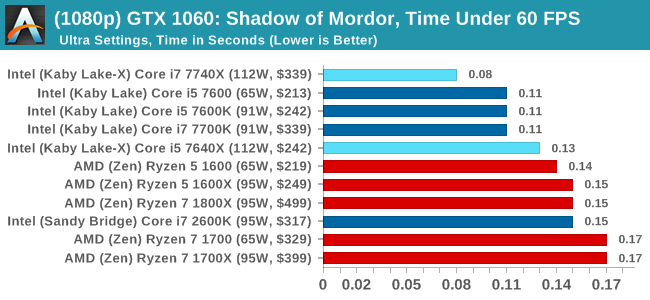
4K
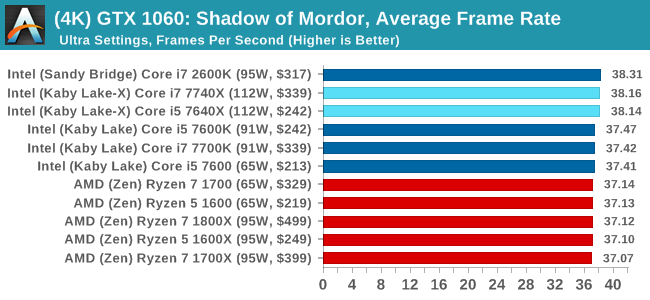
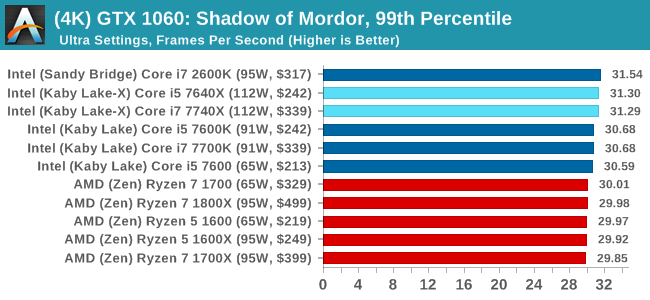
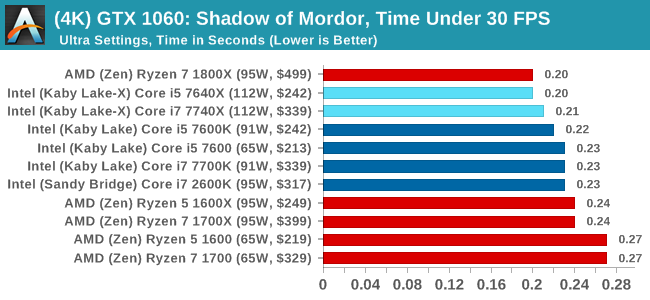
Sapphire R9 Fury 4GB Performance

1080p


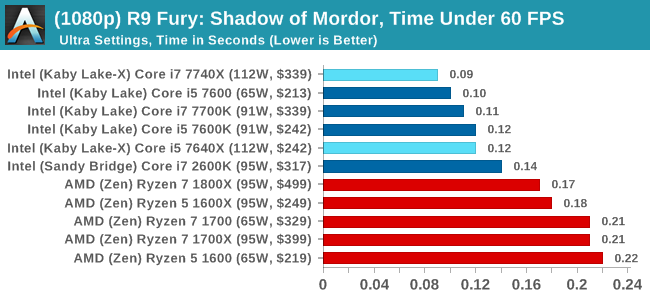
4K
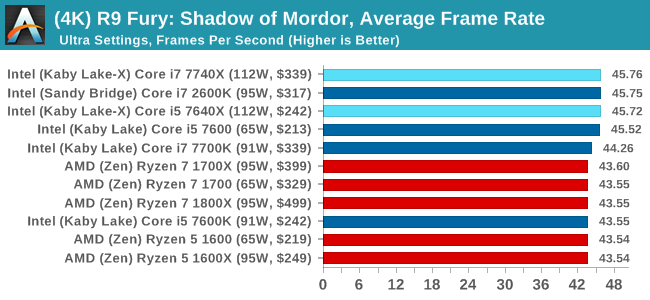
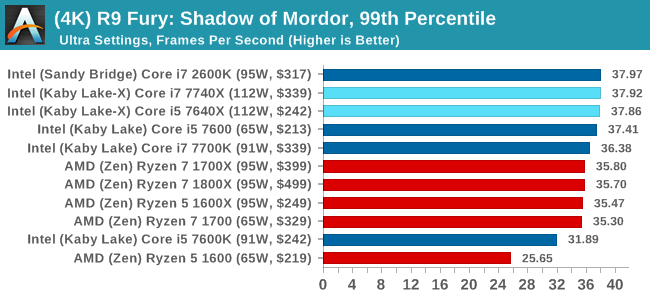

Sapphire RX 480 8GB Performance
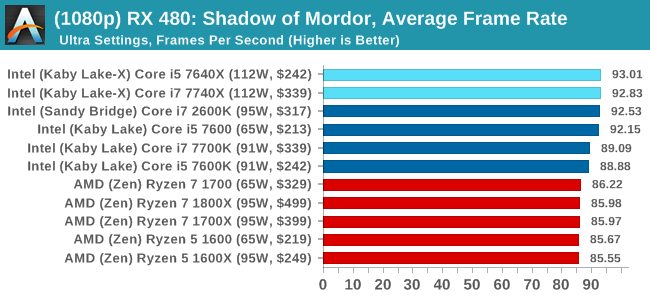
1080p

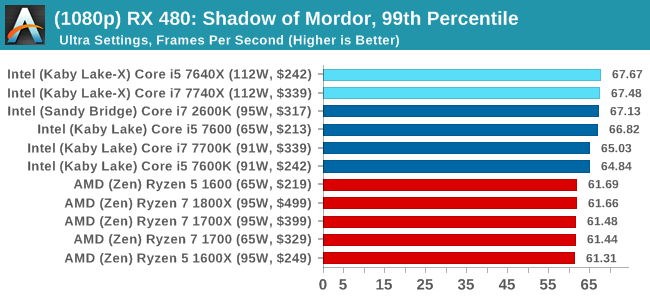
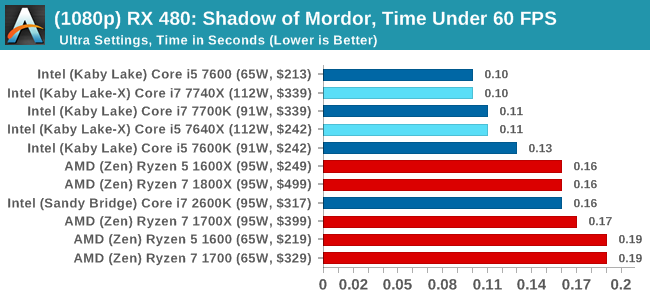
4K
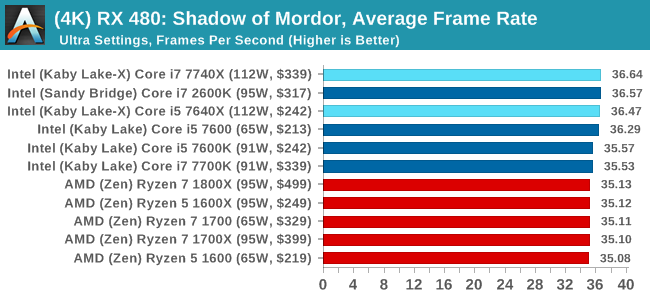
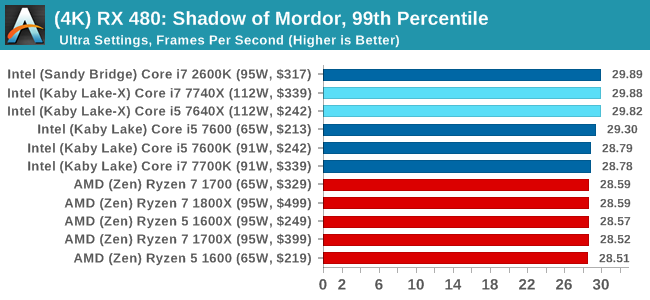
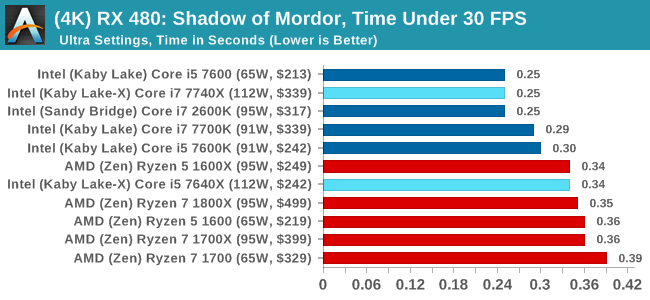
Shadow of Mordor Conclusions
Again, a win across the board for Intel, with the Core i7 taking the top spot in pretty much every scenario. AMD isn't that far behind for the most part.












176 Comments
View All Comments
Alistair - Monday, July 24, 2017 - link
I look at it this way: in 2016 I bought a 6600k for $350 CAD. In 2017 I bought a Ryzen 1700 for $350 CAD. Overall speed increase 240%. So AMD delivered 240 percent more performance at the same price in one year. Intel continues to deliver less than 10 percent per dollar. I could care less if the single performance is the same.Call me next time Intel releases a chip a year later that is 240 percent faster for the same price.
Hurr Durr - Monday, July 24, 2017 - link
So you bought yourself inferior IPC and a sad attempt at ameliorating it by piling up cores, and now have to cope with this through wishful thinking of never materializing performance percents. Classic AMD victim behavior.Alistair - Monday, July 24, 2017 - link
First of all, stop using IPC, an expression you don't understand. Use single core performance. In almost every single benchmark I see dramatic speed improvements. I'm comparing the i5 with a Ryzen 1700 as they were the same cost. People harping over the i7-7700k apparantly didn't notice the 1700 selling for as low as $279 USD.Also get higher fps in almost every single game (Mass Effect Andromeda, Civilization and Overwatch in particular).
Alistair - Tuesday, July 25, 2017 - link
I have tremendous respect for Ian, whose knowledge and integrity is of the highest order. I just think some of his words in this review lose the plot. As he said, "it would appear Intel has an uphill struggle to convince users that Kaby Lake-X is worth the investment". He should have emphasized that a little more.In Canada, Ryzen 1700 plus motherboard = $450. i5 (not i7) plus motherboard is $600. Yes, $150 dollars more!
Intel has 20 percent faster single core performance and yet Ryzen is 2.4 times (+140 percent) faster overall... Numbers should speak for themselves if you don't lose the plot. I agree single threaded performance is very important when the divergence is large, such as Apple's A10 vs Snapdragon 835, or the old Bulldozer. But the single threaded gap has mostly closed and a yawning gulf has opened up in total price/performance. Story of the year!
Hurr Durr - Tuesday, July 25, 2017 - link
Extolling price slashing right after launch, boy you`re on a roll today.silverblue - Tuesday, July 25, 2017 - link
I think you should prove why you think Intel is the superior buy, instead of just trolling and not actually providing any rationale behind your "arguments".On Amazon.co.uk right now, there are four Ryzen and one FX CPU in the top 10. Here's the list (some of the recommended retail price values are missing or a bit - in the case of the 8350 - misleading):
1) i7-7700K £308.00; RRP £415.99
2) R5 1600 £189.19; RRP £219.95
3) R7 1700 £272.89; RRP £315.95
4) i5-7600K £219.99; RRP £?
5) i5-7500 £173.00; RRP £?
6) FX-8350 £105.50; RRP £128.09
7) i5-6500 £175.09; RRP £?
8) R5 1500X £165.99; RRP £189.98
9) Pentium G4400 £48.90; RRP £?
10) R5 1600X £215.79; RRP £249.99
There must be a ton of stupid people buying CPUs now then, or perhaps they just prefer solder as their thermal interface material of choice.
Advantages for Intel right now: clock speed; overclocking headroom past 4 GHz; iGPU (not -X CPUs)
Disadvantages for Intel right now: price; limited availability of G4560; feature segmentation (well, that's always been a factor); overall platform cost
An AMD CPU would probably consume similar amounts of power if they could be pushed past 4.1GHz so I won't list that as a disadvantage for Intel, nor will I list Intel's generally inferior box coolers as not every AMD part comes with one to begin with.
The performance gap in single threaded workloads at the same clock speed has shrunk from 60%+ to about 10%, power consumption has tumbled, and it also looks like AMD scales better as more cores are added. Unless you're just playing old or unoptimised games, or work in a corporate environment where money is no object, I don't see how AMD wouldn't be a viable alternative. That's just me, though - I'm really looking forward to your reasons.
Gothmoth - Tuesday, July 25, 2017 - link
no first of = stop arguing with stupid trolls...prisonerX - Monday, July 24, 2017 - link
I can double my IPC by having another core. Are you really that dumb?Hurr Durr - Tuesday, July 25, 2017 - link
AMD victim calling anyone dumb is peak ironing. You guys are out in force today, does it really hurt so bad?wira123 - Tuesday, July 25, 2017 - link
yeah intel victim is in full force as well today, which is indeed ironic